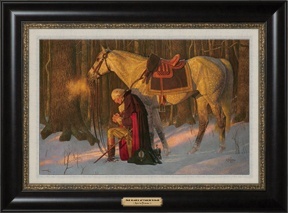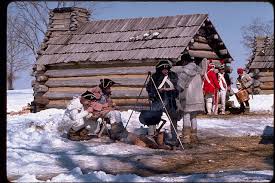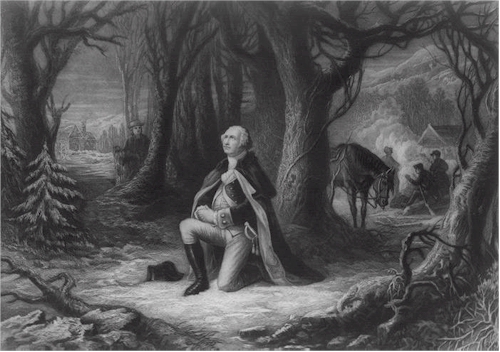The Prayer at Valley Forge
 The Prayer at Valley Forge by Arnold Friberg
The Prayer at Valley Forge by Arnold FribergThe Prayer at Valley Forge by Arnold Friberg is one of the best known paintings of the American Revolution. It depicts George Washington at Valley Forge, Pennsylvania in prayer on his knees beside his horse Nelson at the Continental Army's encampment, during the terrible winter of 1777-1778.
The legendary story was told by a local Quaker Tory named Isaac Potts, who said he spied George Washington praying fervently in the woods alone during one of the bleakest times of the war for the Americans. You can learn more about the horrible conditions at Valley Forge, the alleged prayer of George Washington, including a personal testimony from someone to whom Mr. Potts told the story and the dramatic turnaround that came in the spring.
You can also purchase your own copy of the Prayer at Valley Forge here.
The Events at Valley Forge
The British Army, under the command of Major General William Howe, had captured Philadelphia in the fall of 1777. In those days, it was customary for fighting armies to take up winter quarters during the coldest months of the winter. In accordance, General George Washington chose to take up quarters for his undersupplied and underfed army 25 miles northwest of Philadelphia, near the small town of Valley Forge. This area was a naturally defensible plateau, being bounded on the east by the Schuylkill River, with small creeks that would impede an attack from cavalry or artillery. The British would be forced to move uphill if they made any attack on the Americans.
 Valley Forge Historical Park
Valley Forge Historical ParkThe starving troops marched into Valley Forge on December 19th where their first order of duty was to build suitable housing. General Washington issued orders for the construction of 16x14 huts that would house twelve men apiece. Each hut was built over a pit with a dirt floor. Most of them had only a sheet for a door. The huts were cold, dark and disease ridden.
Food especially was hard to come by. There was food available in the countryside, but getting it to the troops was a daunting task. There were British troops to avoid. The wintry weather made roads impassable. The Continental currency was nearly worthless, making local farmers reluctant to sell their goods to the famished army.
Poor sanitary conditions and close quarters led to rampant disease in the Valley Forge encampment. Typhus and dysentery were rampant. It is estimated that 2,000 to 3,000 men died from disease during that winter.
The Prayer at Valley Forge

George Washington is well known as a Christian believer. He was a regular church attender, Bible reader and giver to missionary organizations. He was known to leave his military camps often on Sundays to attend the services of any church he could find, no matter which denomination it happened to be. He was also a man of prayer, who would often be seen riding into the woods to find a solitary spot to pray, or might be found in his private quarters on his knees with the Bible opened, asking God for help in his endeavors.
The Prayer at Valley Forge is a depiction of one of these moments of intense prayer. It is said that a local British loyalist named Isaac Potts came across Washington praying in the woods one cold, wintry day during that terrible winter of 1777 and 1778. The Potts family owned a local iron forge, to which the name Valley Forge referred, to distinguish it from other forges in the area.
The Pottses were Quakers and loyalists to the British cause. Isaac himself was apparently not connected with the forge at this time, but owned and operated a local grist mill. All the grain that was processed at this grist mill was requisitioned by the Continental Army during the Valley Forge encampment. In addition, General Washington actually stayed in the very home of Isaac Potts during the Valley Forge encampment, requisitioning it as his personal headquarters.
There are some conflicting accounts and questions about the accuracy of the story of Isaac Potts, George Washington and the prayer at Valley Forge. The following account is taken from the "Diary and Remembrances" of the Rev. Nathaniel Randolph Snowden, an ordained Presbyterian minister and graduate of Princeton with a degree from Dickinson College, who was born in 1770 and died in 1851. Rev. Snowden stated:
"I knew personally the celebrated Quaker Potts who saw Gen'l Washington alone in the woods at prayer. I got it from himself, myself. Weems mentioned it in his history of Washington, but I got it from the man myself, as follows: "I was riding with him (Mr. Potts) in Montgomery County, Penn'a near to the Valley Forge, where the army lay during the war of ye Revolution. Mr. Potts was a Senator in our State and a Whig. I told him I was agreeably surprised to find him a friend to his country as the Quakers were mostly Tories. He said, 'It was so and I was a rank Tory once, for I never believed that America c'd proceed against Great Britain whose fleets and armies covered the land and ocean, but something very extraordinary converted me to the Good Faith!" "What was that," I inquired? 'Do you see that woods, and that plain. It was about a quarter of a mile off from the place we were riding, as it happened.' 'There,' said he, 'laid the army of Washington. It was a most distressing time of ye war, and all were for giving up the Ship but that great and good man. In that woods pointing to a close in view, I heard a plaintive sound as, of a man at prayer. I tied my horse to a sapling and went quietly into the woods and to my astonishment I saw the great George Washington on his knees alone, with his sword on one side and his cocked hat on the other. He was at Prayer to the God of the Armies, beseeching to interpose with his Divine aid, as it was ye Crisis, and the cause of the country, of humanity and of the world. 'Such a prayer I never heard from the lips of man. I left him alone praying. 'I went home and told my wife. I saw a sight and heard today what I never saw or heard before, and just related to her what I had seen and heard and observed. We never thought a man c'd be a soldier and a Christian, but if there is one in the world, it is Washington. She also was astonished. We thought it was the cause of God, and America could prevail.' "He then to me put out his right hand and said 'I turned right about and became a Whig.'"
There are several other accounts of the Prayer at Valley Forge, mostly differing in minor details, but remaining substantially the same. One even exists in the writing of Isaac Potts' own daughter Ruth-Anna, who died in 1811. She relates the story even down to the detail of Potts converting to the American cause after seeing General Washington in prayer.
Things change with the spring at Valley Forge
The bright spot that occurred during the Continental Army's sojourn at Valley Forge was that they began a strict training regimen under the direction of Baron Friedrich Wilhelm Ludolf Gerhard Augustin Stueben, better known as Baron von Steuben, a former Prussian captain who was hired by General Washington to inspect the troops and advise on their battle readiness. Baron von Steuben implemented a regular training schedule that taught the previously untrained troops how to use the bayonet, maneuver on the battlefield and mount guard and sentry duty. He also wrote a manual called "Regulation for the Order of Discipline of the Troops of the United States."
Things also changed for the Continental Army in the spring with the appointment of General Nathanael Greene, to replace Thomas Mifflin, as Quartermaster General. The able General Greene quickly built new roads and bridges and food and supplies began to flow into the camp. Another decisive moment occurred during the Valley Forge encampment with the official entry of the French into the war on the side of the Americans in April. French supplies and uniforms soon began arriving in the encampment.
The entrance of France on the side of the Americans forced the British to reassess their strategy of occupying Philadelphia. The French fleet could easily trap the British army in Philadelphia by sailing up the Delaware River. This caused General Howe to decide to abandon Philadelphia in June 1778 and return his army to New York. General Washington and his winter hardened army soon marched back into the city and chased the British as they retreated toward New York through New Jersey. This culminated in the Battle of Monmouth Courthouse in Monmouth, New Jersey. A decisive victor was not really clear, but it was the British who ended up fleeing from General George Washington and his newly trained and professional Continental Army. It is this same army that wound up fighting Lord Cornwallis at York, Virginia only a few years later, causing the defeat of the entire British army.
Even though the encampment at Valley Forge was a trying time for the brave American patriots, with much suffering and loss of life. It was also a valuable time of training and enduring that taught this once underprepared collection of farmers and merchants how to fight and win on the battlefield. Apparently, Isaac Potts' premonition of a victorious George Washington and his American army came to pass and General Washington's prayer at Valley Forge that day in the woods was answered!
Revolutionary War and Beyond Home
Like This Page?
© 2008 - 2022 Revolutionary-War-and-Beyond.com Dan & Jax Bubis










Facebook Comments